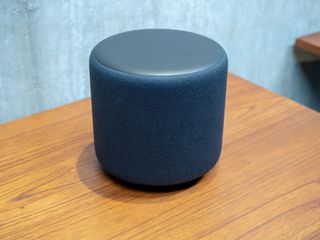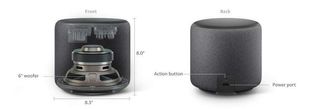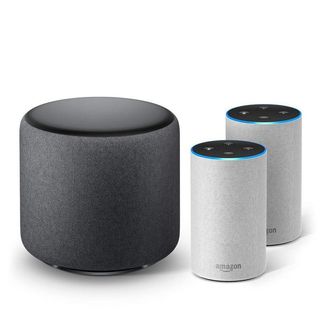Where should I place the Amazon Echo Sub in my room?

Best answer: Ideally, you will want to place your Echo Sub in the third of your room that also has your paired Echo speaker(s), about 12 inches away from any walls, and not under a table or enclosed inside a cabinet of some sort. But placement is not as critical as other subwoofers, so put it where the power cord isn't in the lane of traffic and somewhere between where you sit and where your paired Echo speaker(s) sit and you'll be OK.
Amazon: Echo Sub ($129)
Soundwaves bounce
If you've ever heard your neighbor's stereo when its a bit too loud, you know that walls (and floors and ceilings) aren't great at letting sound pass through. This is even more prominent when dealing with low and ultra low frequency sounds, like those that will come from a subwoofer cabinet. It also means that where you place a subwoofer in your room can make a dramatic impact on the quality of the sound it produces.
Most subwoofers will have a port (a hole in the enclosure designed to allow the sound waves to pass out of the cabinet) on one of the sides or the rear of the enclosure, and some very expensive models will come with plugs that allow you to customize which side of the cube the port is in. The Echo Sub, however, is round and is ported and fires downward. That makes some of the conventional wisdom about subwoofer placement not applicable, or at least not as critical.

A speaker group in the Alexa app also doesn't have any sort of room correction software, which makes placement more critical than systems like Sonos that include it. Don't worry, and don't get confused. The Echo Sub is designed to be user-friendly first and foremost, so room placement is an easy affair.
First things first: an Echo Sub is a wireless subwoofer, but it still requires a power cord. Make sure you place your Echo Sub where nobody will trip over the cord or where people will walk on it. Remember, it's downward firing so placement isn't as critical, but safety always is critical.
Be an expert in 5 minutes
Get the latest news from Android Central, your trusted companion in the world of Android
Next, divide your room into thirds. The Echo speaker(s) you have paired with the sub will be in one-third of the room, and ideally a foot or two away from a wall. Try to place your subwoofer in the same third as the Echo Speakers, but as far away from them as possible. Then move the Echo Sub about a foot away from any walls.
Next, look at where you'll normally be sitting when listening. Ideally, the Echo Sub will be between you and the other Echo Speakers in the group. If that's not the case, try moving the Echo Sub as far away from the other speakers as you are while sitting and listening, but not right beside you. Again, try to be about a foot away from any wall. Things should look something like the image below.

What's left to do is listen to some music with plenty of bass. Ask Alexa to play some hip-hop or Go-Go music, and sit where you normally would. If you hear the bass coming from a specific direction, try to move the Echo Sub closer to you ( but not closer towards the speakers). A subwoofer isn't supposed to sound directional, it's supposed to make the music feel alive by adding bass that fills the room. If that's not possible, try placing it closer to a wall so the sound can "bounce" off of it.
Take your time and if you find a sound you like, try leaving things where they are for a bit, even if it's not where this or any other guide says it should be. You'll dial in the sweet spot for your ears with a bit of trial and error.
A few quick tips:
- Try not to place the Echo Sub under a table or behind the sofa. Both will muffle the sound and with a downward firing sub, you may not be able to save things by moving towards a wall.
- Don't be afraid to move your other speaker(s) if things just can't seem to ever sound "right". Switching sides of the room can make for a completely different soundstage.
- If your room has thick carpet and you can't hear any bass, try placing your Echo Sub on a sturdy piece of thin wood slightly bigger than its footprint. Carpet absorbs soundwaves, too.
- Before you decide having an Echo Sub isn't adding to the sound of your music, try listening to a song several times with it active and then with it unplugged. Often times, a good subwoofer isn't a thing you can pick out and you might be surprised.
Don't be too critical. If you are buying a $1,500 subwoofer you should expect perfection, but an Echo Speaker and Sub group won't have the same sound quality that even an entry-level Sonos has. But you can make your music sound pretty darn good considering the low price of an Echo or two and an Echo Sub.
Rock on!

Add some bottom to your music
The Echo Sub adds much-needed bass to the Echo or Echo Plus. The ability to create a 2.1 system from two Echos paired to the Sub makes it an interesting choice for those looking to stream music, and placement isn't as critical as some other brands of subwoofer.

3-piece audio on a budget
Streaming audio through a 2.1 system with a subwoofer sounds great but has always been a bit expensive to accomplish. the Echo Sub paired with two second-generation Echo Plus devices changes that and this bundle makes for a fine solution for anyone looking for great sound without spending a lot of money.

Jerry is an amateur woodworker and struggling shade tree mechanic. There's nothing he can't take apart, but many things he can't reassemble. You'll find him writing and speaking his loud opinion on Android Central and occasionally on Twitter.
